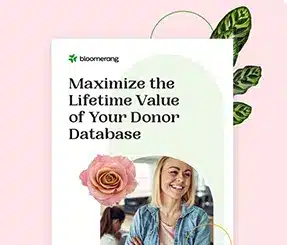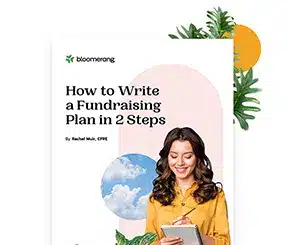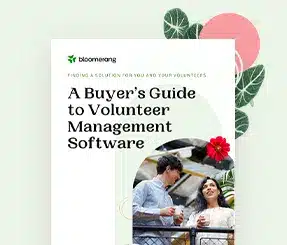How to Find and Engage Major Donors: The Ultimate Guide


Full Platform Overview Chat With Us



Full Platform Overview Chat With Us




As a nonprofit fundraiser, you’ve probably heard some variation of the phrase, “treat every donor like a major donor.” While well-intentioned, this idea is very misleading. If you treat every donor like a major donor, you’d probably run out of team member time. Plus, not all your supporters want to be wined and dined like a major donor.
As an essential and integral part of your fundraising strategy, your major donors should feel valued by your organization. It’s a general rule of thumb that 80% of donations come from 20% of donors, but some studies have found those numbers to be even more lopsided. Bloomerang research found that 88% of donations come from just 12% of donors!
This guide provides key insights about finding major donors and determining the right ways to engage them to solicit major gifts. We’ll cover the following:
Identifying, stewarding, and soliciting major donors takes time and effort, but it’s ultimately worth it when your organization can rely on a solid major giving foundation.
Major donors are the supporters who make the largest donations to your organization and have a significant, direct impact on your mission.
No universal standard exists for what donation amount constitutes a major gift because nonprofits can operate at many levels, from small teams to enterprise-sized organizations. Some nonprofits may define major donors as those who give over $10,000, while other organizations may consider any gift over $1,000 a major gift.
If you don’t already have a major gift portfolio, you can start one by determining who your current major donors are using your donor database. Look at the largest donations to your nonprofit—those who contributed those gifts are considered your major donors.
You can expand your portfolio by conducting prospect research to determine who else in your donor database or broader community has a high propensity and capacity to donate to your cause.
Major donors are vital because they comprise the bulk of fundraising revenue for nonprofit organizations. Because they supply so much funding to your organization, your major donors are the ones who provide the resources you need to keep your nonprofit afloat. They’re key players in your organization’s success and pursuit of your mission.
Plus, the influence and power of major donors are growing. According to data from the Fundraising Effectiveness Project, Q3 2024 saw a 0.9% increase in dollars raised, but a 5.3% decrease in total donors. Also, Giving USA 2024 found that sectors typically associated with major donor giving, like foundations, educational institutions, and arts and cultural organizations, all saw increased donations.
These findings illustrate the crucial need for building strong relationships with major donors.
Major donor prospects are often hiding in plain sight. Prospect research is the process of identifying potential donors who have the wealth and willingness to donate large amounts of money to your cause. Let’s review some best practices to help you find more major donors through prospect research.
Cultivating prospective donors costs time and money. Completing searches in-house with your current donor list reduces the opportunity costs associated with the cultivation process. Since you already share a relationship with your existing donors, these individuals are more likely to contribute major gifts (if they have the capacity to do so).
Dig into your donor database and look for new major donors in the following segments of supporters:
Very few nonprofits have maximized contributions from their current donors, so don’t be too quick to assume you’ve done so. For example, you may think your mid-level donors are maxed out on how much they can give. But they’ve already demonstrated (1) they’re philanthropic, (2) they’re interested in what you do, and (3) they’ve taken an active step to connect their expression of values to yours. You can use prospect research to determine their capacity and desire to make a larger gift.
Your current donor base gives you more to work with than if you tried to immediately go outside your database to find new major donors, so start here before looking elsewhere.
Those who share a belief in and passion for your cause are emotionally driven to have a greater impact on your mission. That’s why reviewing your donor database is essential to find donors who have exhibited this passion through recent engagement with your organization.
Review your donor files to evaluate donors’ giving histories and identify your most loyal, faithful donors. The recency of a gift is an important consideration here. The best rule of thumb is to target donors who have given within the last 12 months. This targeting allows you to focus efforts on donors who are interested now.
Cumulative giving is also a positive attribute to look for in these donors. Those who give frequently may be the most receptive to requests for larger contributions.
The next step is to develop a strategy to understand your mid-level donors more deeply. Many major donors start at lower levels of the giving pyramid. Volunteers, event attendees, annual fund donors, or people you have engaged with on some level through your emails and newsletters are often great candidates to move up the pyramid—they just need to receive some personal attention to motivate them.
Plus, research from Sea Change Strategies shows that mid-level donors are often significant contributors of planned gifts and bequests. Their research found that one in three mid-level donors have already made a bequest to a charity, and 23% plan to make one later.
To get mid-level donors thinking about major gift opportunities, ask these candidates what interests them about your cause. What drives them to attend your event or make a gift? Take this knowledge and match their passions with your organization’s projects and programs.
For example, if a supporter has expressed interest in your food bank, you may email them when campaigns supporting this program are coming up. Then, you can determine who has the potential to give more, give again, or give to a new project.
Whether you’re considering existing donors or new prospects, if their beliefs align with your cause, then the next step is to assess the wealth factor. Determine whether the donors can give more.
In the first few steps, we discussed finding prospects who share a passion for and believe in your cause. When you start with this passion first, you have a better chance of reaching the ideal gift potential amount.
Then, review supporters’ wealth indicators such as:
This type of wealth screening can reveal whether supporters have the financial capacity to provide the gift amounts you’re seeking.
Remember, capacity does not necessarily mean generosity. Despite having excess financial capacity, someone who has not expressed any interest may not be worth your valuable time.
Again, the focus should initially be cultivating, stewarding, and managing your current major donor portfolio before “chasing” new prospects. However, you should still expand some resources to target new prospects. The following strategies will help you connect with donor prospects outside your current donor pool.
Seek out nonprofits with a mission similar to your organization’s. This strategy is a good way to find donors who believe in your cause.
Conduct prospect research to find annual reports from these similar nonprofits. These reports can provide information about other major donors, such as names and their general giving level. Many prospects focus their gifts on particular causes and may be willing to expand their giving to your cause.
Capitalize on informal networks to find others who might be interested in your organization. Many of your major donors are actively involved in the community and serve on various foundation and corporation boards. They likely have connections to people with the capacity and willingness to give.
Narrow your focus on the top 2-3% of donors from the tip of the donor pyramid. Always leave resources available to invest time in these relationships. It’s worth putting extra effort into those with the deepest pockets. But, prioritize the most likely “yes” candidates in your major donor cultivation plan. Put most of your time and effort into the opportunities that will likely result in major gifts. We’ll cover this in more detail in the next section.
Hosting and attending events can be an excellent opportunity to make contacts and develop relationships with new prospects. For example, some organizations host open houses, auctions, galas, or other special events.
Pay attention to current and prospective major donors during these opportunities, whether a one-time event or an opportunity for ongoing interaction. Prepare ahead of time by tracking who will be in attendance and planning to engage them during the event.
In the last section, we mentioned that you should start with your donor database to identify the major donors you want to cultivate. But when you’re making this determination, do you simply look at everyone who gave more than $1,000 (or whatever your major gift amount is) and dump them all into your portfolio for the year?
This approach runs the risk of too many results and an inflated donor portfolio that uses too much of your major gift officer’s time. Qualification and ranking will help narrow down your most prominent prospects.
Qualification is like cultivation-lite. You make a few preliminary “moves” to see if the donor bites. If they do, you know they’ll likely respond to continued cultivation. This makes them worth including in your portfolio.
One marketing approach your organization may use is the “Rule of Seven.” In most cases, it will take seven tries to connect with a potential donor over three months. If you make a good faith effort and your prospect doesn’t “bite,” move on. This prospect doesn’t belong in your major donor portfolio for cultivation.
Here’s what to do to get the answers you need:
If a donor seems receptive, add them to your portfolio. If they fail to respond, you’ll know that adding them to your portfolio will bear no fruit. Keep them where they are, ensuring they continue receiving a regular flow of information from your organization.
Ranking your major donors involves tiering them by their capacity and likelihood of giving a major gift. By determining who the top-tier supporters are, you can allocate time to them while still providing the necessary resources and time for lower tiers.
This concept is illustrated below as a tiered cake. The yummiest tier is the top. You want to spend 50% of your time here, then 30% with the next tier.
You’ll also benefit from engaging with the lower tiers—but not as much. Renewing mid-level and major gifts at the same level they’ve always given is the easiest thing to do, but you don’t want to get stuck there because you’ll never grow. If you try to over-indulge on the bottom tiers, you’ll just get sick. It’s too much. The bottom-level tier belongs in your regular annual giving track.
Tier folks into A, B, and C groupings based on both (1) capacity to give and, just as important (if not more important), (2) how close they are to being ready to make a major gift.
Use wealth indicators to determine the capacity of supporters. Generally, this can be done through research and tools built into your donor database showing supporters’ generosity. You’ll be able to figure out how close they are to making a major gift based on their pattern of giving (how recently they’ve given, the pattern of increases, how frequently they’ve given, and other types of active affiliation and engagement with your cause).
Here is how to proceed:
The tier you’ve chosen for your donors (A, B, or C) is never set in stone. As you continue with moves, you may discover the donor still doesn’t say yes or says yes at a level that doesn’t merit keeping them in their current tier. Recalibrate when things start to feel like they’re not working, so you can move folks to another tier.
Here are some options for moving your supporters between various tiers:
Cultivating your major donors is never a one-size-fits-all process. If all of your outreach and touches are the same among all supporters, your organization doesn’t have a major donor program; it has a donor renewal program. As a result, most donors would give precisely what they gave the previous year. High retention levels aren’t bad, of course, but this strategy leaves money on the table.
Don’t just throw a bunch of ‘touches’ and ‘moves’ at your prospects. Work with them. Once a donor qualifies for your portfolio, the next task is building a relationship. No cold calls. No cookie-cutter plans.
Spend time thinking about what moves you’ll measure, trying to reduce your pipeline to the smallest number of moves possible. Measure only activities that get you closer to a gift. Sending a holiday greeting card won’t help much, but setting up an in-person meeting with the director will.
Here are a few additional tips for growing relationships with major donors:
Have your CEO or a board member call your major donors, whether it is to thank them, invite them to a cultivation event, ask for their input or feedback on an idea, or share a new issue or challenge your organization is facing.
While pitching your organization on these calls can be tempting, this type of communication will fall flat, especially if your donor is primarily interested in just one of your programs. To build a genuine relationship, use this opportunity to get to know your donors by asking them questions about how and why they became engaged in your cause.
Make your digital touchpoints more meaningful by addressing them with your executive director or CEO’s signature.
When you send these regular communications, be sure they sound familiar. The message should have the same personal feel as a holiday letter you’d send to your friends and family, updating them on your life. Instead of sharing information about your latest family vacation, you’ll share the latest information and impact data about your organization and mission.
This helps your major donors feel like they are part of the community, among other like-minded people who share their values. Communicating openly and updating supporters regularly can make these important supporters feel like they are a part of something larger than themselves.
Once a year, make sure you call or meet with major donors to inform them personally about how their support has benefited particular programs and projects. Give them specific numbers of additional people served, lives saved, families fed, etc.
Meet with your donors face-to-face once a year and ask for their feedback. Spend 80% of the time listening and only 20% talking. Ask what advice they have for you. Find out how you could be doing a better job of telling your story in the community. Share some of the challenges your organization is facing.
As a fundraiser, you’re likely going to face objections from donors. Very few donors will immediately say yes without a little bit of pushback. This is especially true when the donor is unclear about your organization’s mission and general concept. This is not a crisis; rather, it’s an opportunity.
Consider your donor prospect’s perspective:
When you receive pushback like this, remember that you can make a big difference by simply listening and responding to their questions and concerns. These can even be opportunities to get to know your major donor better! In response to hesitations, be sure to:
Don’t be a fundraising arm-twister. Instead, gently take folks by the hand and walk them down a pathway towards enacting their passions.
Sometimes, people’s passions don’t mesh with yours, and that’s perfectly okay. For these people, “no” means “not a good fit,” and you should move on.
Often, people just need some help reframing their decision-making process. They may be thinking out loud and looking for a way to be convinced this is a good decision. This means you must put yourself in their shoes, listen carefully, empathize, and show them ways they might feel comfortable proceeding with a gift.
Instead of walking in afraid they’ll say “no” or “but,” consider whatever they say to be the opening up of a conversation. One in which they’re waiting for you to persuade them that you’re offering them a worthwhile investment.
Finding, engaging, and retaining major donors is easier when you use nonprofit software solutions specifically designed for highlighting and maximizing major giving opportunities. We recommend leveraging a nonprofit CRM solution like Bloomerang to access built-in major giving and prospecting insights directly in your donor database.
Let’s explore how Bloomerang helps organizations make the most of major giving. You can use our tools to:
Plus, Bloomerang’s simple trend reporting tools help surface important donor giving patterns, giving you a fuller picture of donor behavior.
Learn more about our solution here:
While all supporters are important, don’t fall into the trap of “treating everyone like a major donor.” Cultivating your major donors takes time and dedicated relationship-building strategies, so give them the attention they deserve.
If you’re interested in learning more about major donors and your major gift strategy, check out these additional resources:
Comments
Karolina Czupryniak